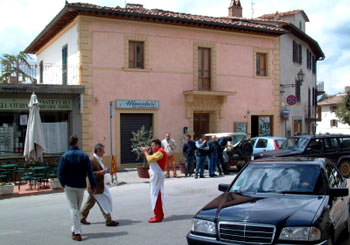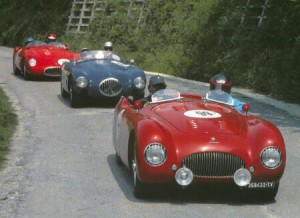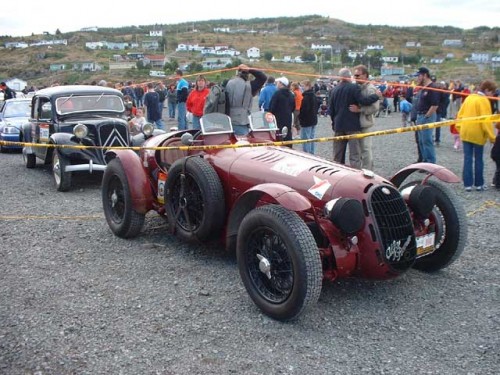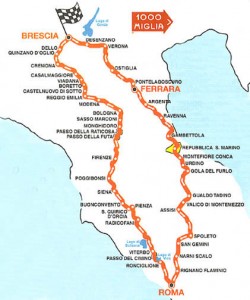I still remember the day in Panzano when I almost plowed down Dario Cecchini, the famed butcher, who was standing in the intersection blowing a horn that once graced the side of an ancient automobile – back in the times when the horn had to be sounded to get the horses and carriages out of the way. Dario was garbed in festive red pants, yellow shirt, red vest, and white apron with a red bandana at his neck. He had a glass of red wine in his other hand.

Just as Dario blew two long welcoming notes, three antique racing cars crested the hill, tooted to Dario and raced off into the valley to Greve. I got a glass of Dario’s wine and a small plate of bread, lardo and salami from Dario’s butcher shop and joined the crowd of spectators in Panzano’s main piazza.
The Mille Miglia had come to town.
This year it will run from May 13 to 17.
Anyone living in or visiting Italy next week has the chance to be part of the pageantry of this annual road rally of vintage sport and touring cars. The 27th Mille Miglia, a historic replay of one the world’s most famous motor races (the original race ran between 1927 and 1957), is a three-day rally that starts in Brescia, Lombardia, travels to Rome, winding through the countryside of the Veneto, Marche and Umbria, and returning through Tuscany (Pienza, Buonconvento, Siena, Val d’Elsa, Monteriggioni, Poggibonsi, Barberino, Tavernelle and San Casciano) and Florence. Over three hundred antique racing and tourist-class cars will pause for a break in Siena and Florence in mid-afternoon on May 16.

Mille Miglia fever still infects international vintage automobile enthusiasts so that every year hundreds of entry applications from dozens of countries are sent to the organizing committee, which has to choose the final 375 competitors admitted to the 2009 competition.
Possession of a veteran car does not mean that the automobile has all the necessary qualifications for admission. Only cars built during the period of the classic Mille Miglia, 1927 -1957, are allowed to come to the starting line in Brescia. Preference is given to cars that have a particular racing history or which have actually participated in a previous Mille Miglia.
Each car must carry two qualified drivers, one of whom usually acts as navigator. Taking part in the Mille Miglia has always been considered an achievement in itself, but managing to finish the arduous course takes the experience to another level.
The Mille Miglia highlights ancient villages, city centers, countryside and mountains. From the Lombardia and Veneto plains to the countryside of the Marche and of Umbria, Lazio, Tuscany and Emilia, from the Romagna sea to the steep snowy slopes of Mount Terminillo and, on the way back, up again across the Futa and Raticosa passes. The rally also visits almost unknown tiny villages of medieval origin and the famous city squares, including the Campo in Siena and Piazza Strozzi in Florence.

Among the cars in this year’s Mille Miglia is the Mercedes 3300 SLR, the BMW 328 Coupe, both the Ferrari 340A and 212 Spider Vignale, the Alfa Romeo 1750 GS and the Alfa 1500 SS Spider, both the OM 665 TT and the 665 S, the Bugatti T35A and T40GS, the Jaguar C-Type and D-Type, the Maserati A6 GCS and Maserati Monofaro, the Aston Martin DB3 Spider, the Fiat 1100 S, the 1954 Autobleu 750 MM, and the egg-shaped Isetta. Among the most rare cars are the Gilco Panhard 1100 Sport of 1952 and the Chrysler 1951 Saratoga.
Spectators enjoy the pageantry of the Mille Miglia whether they understand the detailed lineage of the vintage automobiles or not. Along the route residents and spectators hold outdoor parties, wave flags, blow horns, ring bells and cheer the racers onward. Car enthusiasts will have the chance in Siena and Florence to examine the cars and talk with the drivers.

For more information in English (not much) and Italian, review the official web site at 1000milglia.com.
